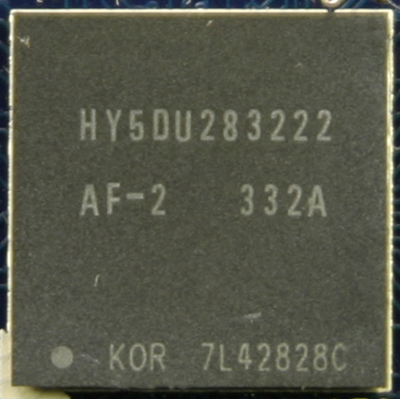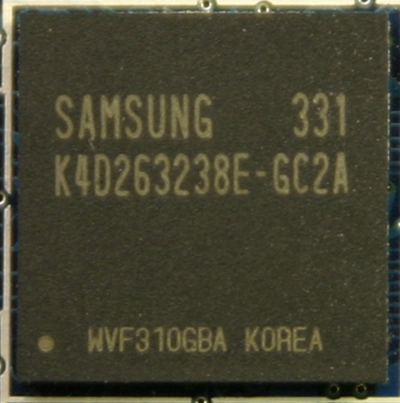Memory Modules
Before DX9 cards came along, memory speed and bandwidth were all important. There were plenty of instances in which GPUs were starved for action because they weren't able to get data fast enough. Now, though, raw computing power is presenting itself as the main driving force behind high quality graphics. The reason for this is that some cool effects, which used to be done with a memory trick, can now be done programmatically with pixel and vertex shaders. This doesn't mean that having fast memory is unimportant (we still need to move a high volume of data), and we are going to try to get as much data flowing as possible for this review.The two memory makers that we are going to see coming to the plate in this roundup are Samsung and Hynix. On both ATI's and NVIDIA's top end cards, we are seeing Hynix GDDR-II modules on board, while the mid-range products are outfitted with the Samsung parts.

Hynix 2ns Ram Module
The high-end Hynix HY5DU283222 and Hynix HY5DU573222 are used on NVIDIA 59xx and Radeon 98xx cards, respectively. NVIDIA requires 2ns RAM for its 5950 cards to hit a 950 MHz data rate, while ATI only needs the 2.5ns modules, as it doesn't need more than an 800MHz data rate. The NVIDIA GeForce FX 5900 that we tested sports 2.8ns Hynix RAM rather than the 2ns of the 5950s.

Samsung 2.8ns Ram Module
RAM for the Radeon 9600XT tops out at 700MHz effective rate speeds, which is more than enough room to hit the reference specification of a 600MHz data rate. The Samsung RAM that NVIDIA employs is a bit faster at 2.2ns, and we have seen some cases where this RAM ran stable beyond the 900MHz data rate, which should have been its limit.
The modules themselves have a great deal to do with how fast the memory on a graphics card can be run, but beyond the simple specs of the memory itself, performance is affected greatly by board layout, latency settings, and cooling. All of these aspects are controlled by the OEM, and all of them have a large impact on how well memory on a card will overclock.
The first thing that we had hoped for when we saw that Crucial had entered the graphics card market was that they would equip their cards with their own RAM. Unfortunately, that's not the case, as all the cards that we've seen from them follow suit with the other cards in their category.
Since we aren't seeing any variation on what RAM OEMs are pairing GPUs, the variances in RAM speed among similar cards will be due to the aspects that we mentioned before, as well as a little luck of the draw (overclocking isn't an exact science, and every single part is unique even if its from the same batch of chips).










44 Comments
View All Comments
KristopherKubicki - Wednesday, February 4, 2004 - link
Very well done.Icewind - Wednesday, February 4, 2004 - link
I'd like to know how the freak the Nvidia cards outdid the ATI's in Halo and UT2k3, thats just beyond me.TheSnowman - Wednesday, February 4, 2004 - link
hum Derek, i don't suppose you know why the nvidia based high end cards idle at so much lower temperature when compared to the ati based offerings?AnonymouseUser - Wednesday, February 4, 2004 - link
Nice roundup. The 5900se (priced similar to the 5700 Ultra and 9600XT) is what I find most impressive.Abraxas - Wednesday, February 4, 2004 - link
great review, this is the first of its type that i've seen and it really changed my mind on what card to buy. I would like to see 1280x1024 or even 1600x1200 in a future review, but even at 1024 it is nice.53.03 is really that much faster? that's just amazing.
#7 ATI held a huge advantage on older drivers in HALO, just as much as in HL2. if the new drivers are that much faster... it appears that nvidia should never have been doubted :)
DerekWilson - Wednesday, February 4, 2004 - link
Sorry Icewind, we didn't include numbers for stock 9800pro, 5900(ultra/non-ultra/se/xt) or any stock card other than the newest releases. Most other reviews cover reference cards running stock numbers, but we just needed one reference point to show where these numbers fell and give people a basis to judge performance increase.Iger, there are a few reasons for what you are seeing. I would say that your questions were the correct ones to ask.
We could only use a couple benchmarks, and the couple we chose are standardish (UT2K3), based on very common engines (JKJA), or one of the few available (Halo having PS2.0 support). These were not the games with huge performance gaps between them (like Tomb Raider or Tron). Also, since we were including 5700 and 9600 parts, we wanted to stick with the standard-but-lowish 1024x768 resolution rather than bump up a 1280 flavor.
There is also one other thing that has been overlooked. Since the fall, there have been some driver changes. We've moved up to 53.03 for NVIDIA (which brough some noticeable performance increases) and the CATALYST 4.1 drivers which we have yet to give a good work out.
In future reviews of this type, we plan on going with higher resolutions even if we include midrange cards. So the question we leave to the readers is this: how high do we go? 1152x864, 1280x960, 1280x1024 or 1600x1200 ...
Lonyo - Wednesday, February 4, 2004 - link
Most 9800's seem to be able to hit about 450MHz at the very max. Even the 9800 non-pro's (mine can get to 440MHz, but I run at 430MHz).Seems like a limit of the chip at about that sort of level.
drpepper1280 - Wednesday, February 4, 2004 - link
To answer a few questions, the passivly cooled 9600xt is on newegg, its the ultimate version. If you search by category it is at the bottom. Also the reason the nvidia cards do well against the ati cards is because they are overclocked in the bench marks (I'm pretty sure), also none of the bench marks are Half Life 2, lol. I had one question even before viewing the article, how does sapphires 9600xt 256mb stand up. Unfortunetly it was not reviewed, but I did read the the 9600xt could benifit from a memory increase. This makes me wonder if the 9600xt 256mb is actually a really good deal (it only cost 170 dollars), or if it is like many 256mb cards that actually decrease performance.Iger - Wednesday, February 4, 2004 - link
It's strange it almost doesn't correspond with the fall test of FX5950 against 9800XT... There 9800XT looked much stronger... Now even the reference XT looks weaker, than FX. Maybe that's because the fall test was at higher resolutions? Or just not enough tests to see the big picture?tfranzese - Wednesday, February 4, 2004 - link
Good article. Impressed with both camp's overclocking headroom.